Change Management in Business: Apple and Samsung Case Study
VerifiedAdded on 2020/07/22
|12
|3877
|38
Report
AI Summary
This report provides a comprehensive analysis of change management within the context of Apple and Samsung. It begins by examining the impact of change on organizational strategies and operations, highlighting the importance of adaptation and strategic planning. The report then delves into how both internal and external drivers, such as strengths, weaknesses, opportunities, and threats, influence leadership, team dynamics, and individual behavior, emphasizing the role of managers and leaders in navigating these factors. Furthermore, the report discusses various measures organizations can take to minimize the negative impacts of change, including effective communication, employee engagement, and feedback mechanisms. It also explores the different barriers to change, such as resistance, and their influence on HRM decision-making. Finally, the report examines different leadership approaches to deal with change, providing insights into how leaders can effectively guide their organizations through transitions, ultimately fostering growth and competitiveness. The report uses examples from Apple and Samsung to illustrate key concepts.
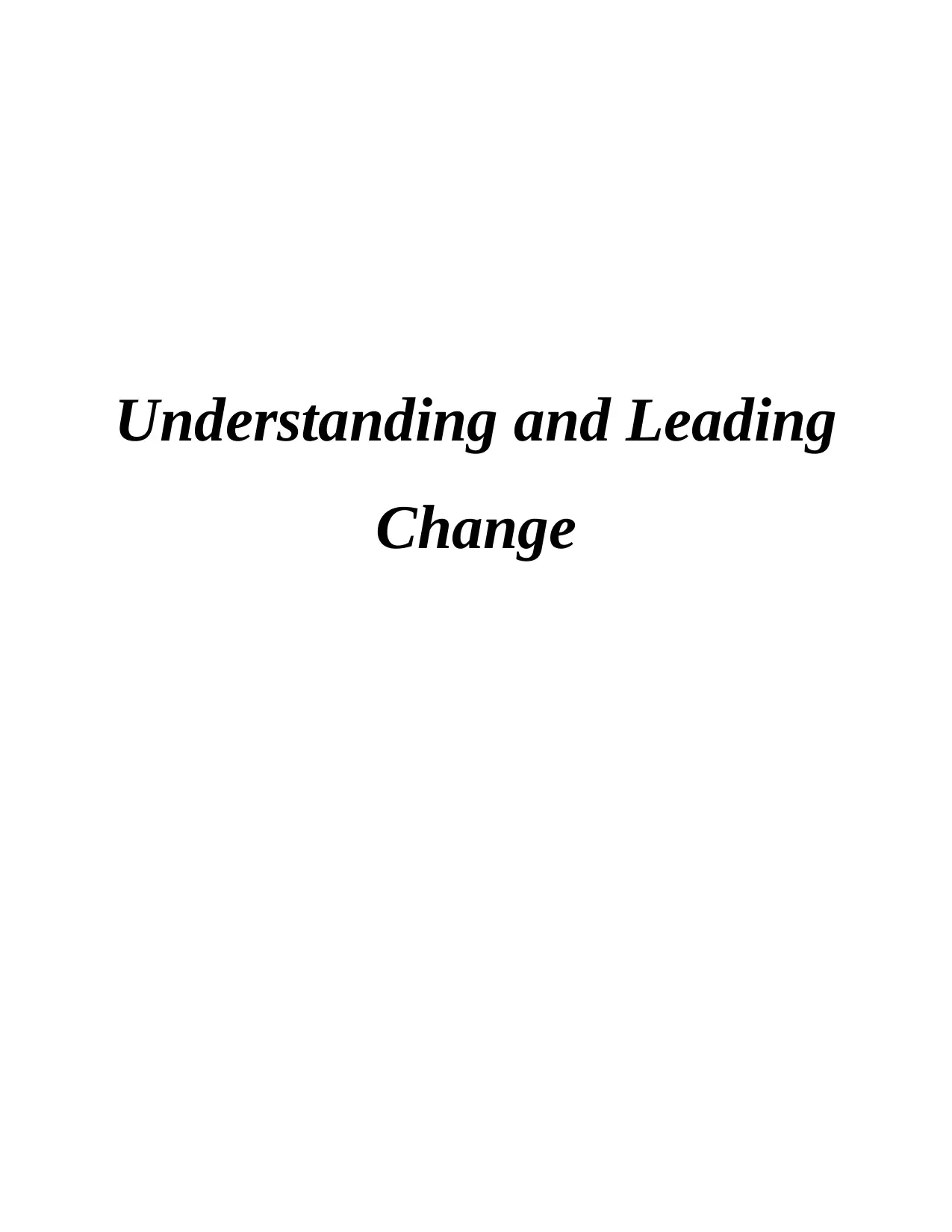
Understanding and Leading
Change
Change
Paraphrase This Document
Need a fresh take? Get an instant paraphrase of this document with our AI Paraphraser
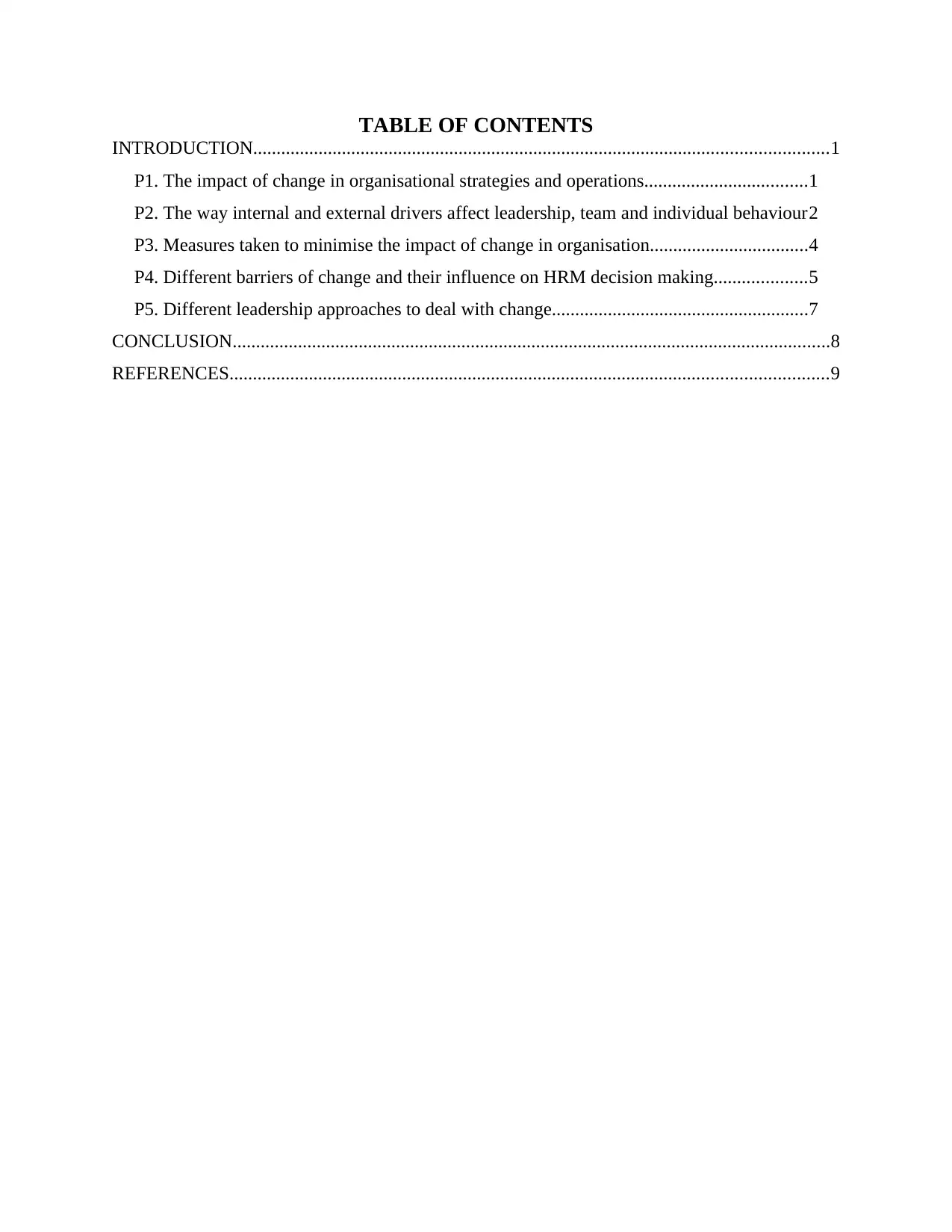
TABLE OF CONTENTS
INTRODUCTION...........................................................................................................................1
P1. The impact of change in organisational strategies and operations...................................1
P2. The way internal and external drivers affect leadership, team and individual behaviour2
P3. Measures taken to minimise the impact of change in organisation..................................4
P4. Different barriers of change and their influence on HRM decision making....................5
P5. Different leadership approaches to deal with change.......................................................7
CONCLUSION................................................................................................................................8
REFERENCES................................................................................................................................9
INTRODUCTION...........................................................................................................................1
P1. The impact of change in organisational strategies and operations...................................1
P2. The way internal and external drivers affect leadership, team and individual behaviour2
P3. Measures taken to minimise the impact of change in organisation..................................4
P4. Different barriers of change and their influence on HRM decision making....................5
P5. Different leadership approaches to deal with change.......................................................7
CONCLUSION................................................................................................................................8
REFERENCES................................................................................................................................9
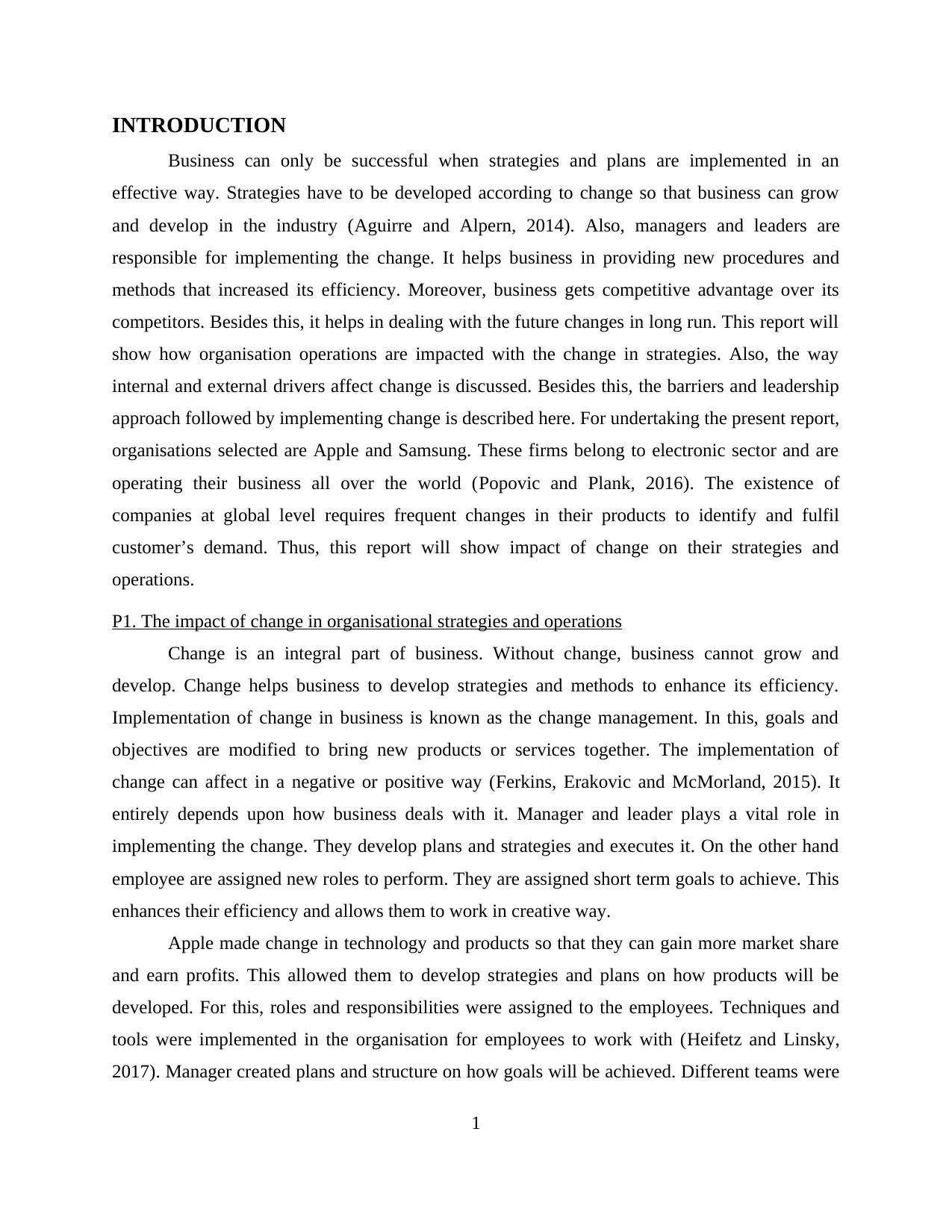
INTRODUCTION
Business can only be successful when strategies and plans are implemented in an
effective way. Strategies have to be developed according to change so that business can grow
and develop in the industry (Aguirre and Alpern, 2014). Also, managers and leaders are
responsible for implementing the change. It helps business in providing new procedures and
methods that increased its efficiency. Moreover, business gets competitive advantage over its
competitors. Besides this, it helps in dealing with the future changes in long run. This report will
show how organisation operations are impacted with the change in strategies. Also, the way
internal and external drivers affect change is discussed. Besides this, the barriers and leadership
approach followed by implementing change is described here. For undertaking the present report,
organisations selected are Apple and Samsung. These firms belong to electronic sector and are
operating their business all over the world (Popovic and Plank, 2016). The existence of
companies at global level requires frequent changes in their products to identify and fulfil
customer’s demand. Thus, this report will show impact of change on their strategies and
operations.
P1. The impact of change in organisational strategies and operations
Change is an integral part of business. Without change, business cannot grow and
develop. Change helps business to develop strategies and methods to enhance its efficiency.
Implementation of change in business is known as the change management. In this, goals and
objectives are modified to bring new products or services together. The implementation of
change can affect in a negative or positive way (Ferkins, Erakovic and McMorland, 2015). It
entirely depends upon how business deals with it. Manager and leader plays a vital role in
implementing the change. They develop plans and strategies and executes it. On the other hand
employee are assigned new roles to perform. They are assigned short term goals to achieve. This
enhances their efficiency and allows them to work in creative way.
Apple made change in technology and products so that they can gain more market share
and earn profits. This allowed them to develop strategies and plans on how products will be
developed. For this, roles and responsibilities were assigned to the employees. Techniques and
tools were implemented in the organisation for employees to work with (Heifetz and Linsky,
2017). Manager created plans and structure on how goals will be achieved. Different teams were
1
Business can only be successful when strategies and plans are implemented in an
effective way. Strategies have to be developed according to change so that business can grow
and develop in the industry (Aguirre and Alpern, 2014). Also, managers and leaders are
responsible for implementing the change. It helps business in providing new procedures and
methods that increased its efficiency. Moreover, business gets competitive advantage over its
competitors. Besides this, it helps in dealing with the future changes in long run. This report will
show how organisation operations are impacted with the change in strategies. Also, the way
internal and external drivers affect change is discussed. Besides this, the barriers and leadership
approach followed by implementing change is described here. For undertaking the present report,
organisations selected are Apple and Samsung. These firms belong to electronic sector and are
operating their business all over the world (Popovic and Plank, 2016). The existence of
companies at global level requires frequent changes in their products to identify and fulfil
customer’s demand. Thus, this report will show impact of change on their strategies and
operations.
P1. The impact of change in organisational strategies and operations
Change is an integral part of business. Without change, business cannot grow and
develop. Change helps business to develop strategies and methods to enhance its efficiency.
Implementation of change in business is known as the change management. In this, goals and
objectives are modified to bring new products or services together. The implementation of
change can affect in a negative or positive way (Ferkins, Erakovic and McMorland, 2015). It
entirely depends upon how business deals with it. Manager and leader plays a vital role in
implementing the change. They develop plans and strategies and executes it. On the other hand
employee are assigned new roles to perform. They are assigned short term goals to achieve. This
enhances their efficiency and allows them to work in creative way.
Apple made change in technology and products so that they can gain more market share
and earn profits. This allowed them to develop strategies and plans on how products will be
developed. For this, roles and responsibilities were assigned to the employees. Techniques and
tools were implemented in the organisation for employees to work with (Heifetz and Linsky,
2017). Manager created plans and structure on how goals will be achieved. Different teams were
1
⊘ This is a preview!⊘
Do you want full access?
Subscribe today to unlock all pages.

Trusted by 1+ million students worldwide
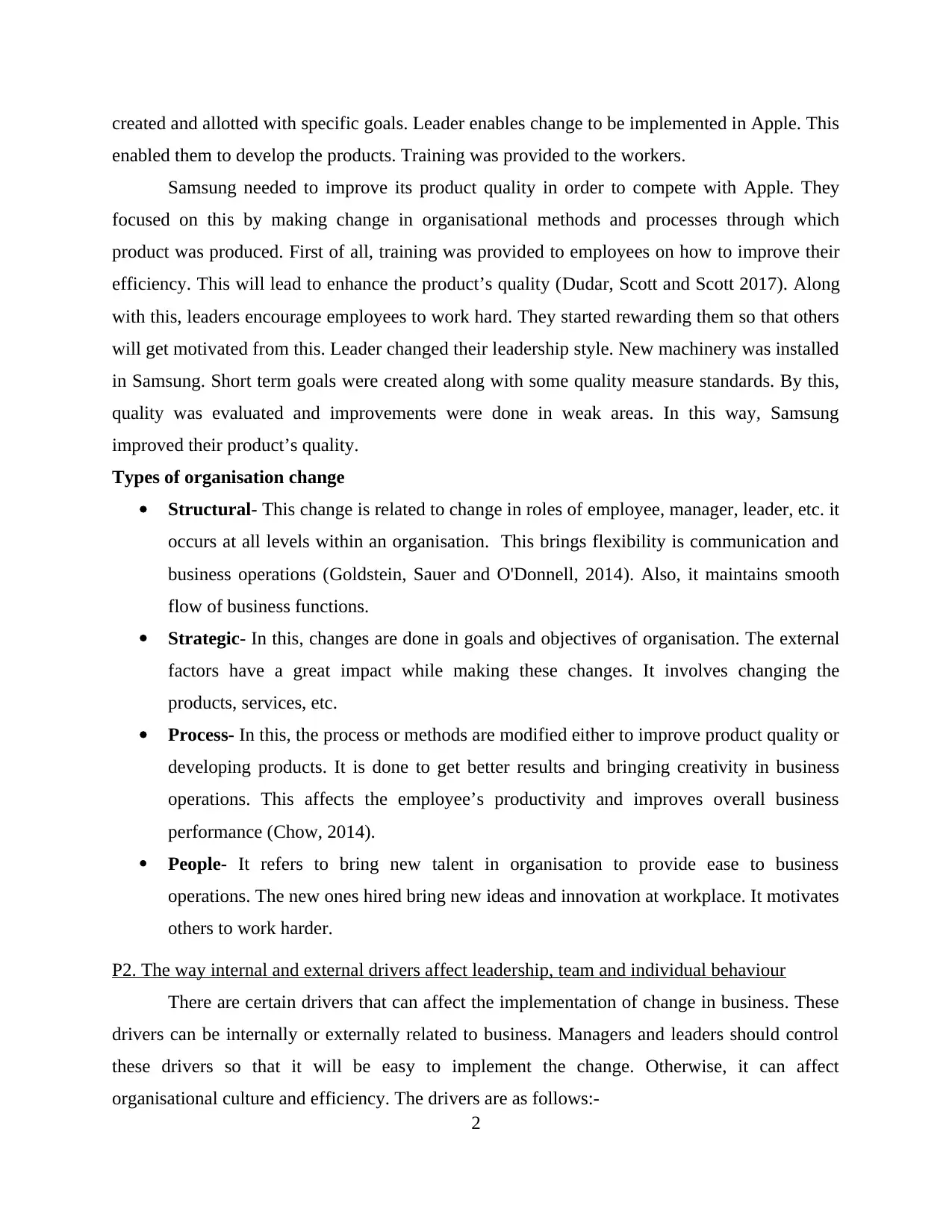
created and allotted with specific goals. Leader enables change to be implemented in Apple. This
enabled them to develop the products. Training was provided to the workers.
Samsung needed to improve its product quality in order to compete with Apple. They
focused on this by making change in organisational methods and processes through which
product was produced. First of all, training was provided to employees on how to improve their
efficiency. This will lead to enhance the product’s quality (Dudar, Scott and Scott 2017). Along
with this, leaders encourage employees to work hard. They started rewarding them so that others
will get motivated from this. Leader changed their leadership style. New machinery was installed
in Samsung. Short term goals were created along with some quality measure standards. By this,
quality was evaluated and improvements were done in weak areas. In this way, Samsung
improved their product’s quality.
Types of organisation change
Structural- This change is related to change in roles of employee, manager, leader, etc. it
occurs at all levels within an organisation. This brings flexibility is communication and
business operations (Goldstein, Sauer and O'Donnell, 2014). Also, it maintains smooth
flow of business functions.
Strategic- In this, changes are done in goals and objectives of organisation. The external
factors have a great impact while making these changes. It involves changing the
products, services, etc.
Process- In this, the process or methods are modified either to improve product quality or
developing products. It is done to get better results and bringing creativity in business
operations. This affects the employee’s productivity and improves overall business
performance (Chow, 2014).
People- It refers to bring new talent in organisation to provide ease to business
operations. The new ones hired bring new ideas and innovation at workplace. It motivates
others to work harder.
P2. The way internal and external drivers affect leadership, team and individual behaviour
There are certain drivers that can affect the implementation of change in business. These
drivers can be internally or externally related to business. Managers and leaders should control
these drivers so that it will be easy to implement the change. Otherwise, it can affect
organisational culture and efficiency. The drivers are as follows:-
2
enabled them to develop the products. Training was provided to the workers.
Samsung needed to improve its product quality in order to compete with Apple. They
focused on this by making change in organisational methods and processes through which
product was produced. First of all, training was provided to employees on how to improve their
efficiency. This will lead to enhance the product’s quality (Dudar, Scott and Scott 2017). Along
with this, leaders encourage employees to work hard. They started rewarding them so that others
will get motivated from this. Leader changed their leadership style. New machinery was installed
in Samsung. Short term goals were created along with some quality measure standards. By this,
quality was evaluated and improvements were done in weak areas. In this way, Samsung
improved their product’s quality.
Types of organisation change
Structural- This change is related to change in roles of employee, manager, leader, etc. it
occurs at all levels within an organisation. This brings flexibility is communication and
business operations (Goldstein, Sauer and O'Donnell, 2014). Also, it maintains smooth
flow of business functions.
Strategic- In this, changes are done in goals and objectives of organisation. The external
factors have a great impact while making these changes. It involves changing the
products, services, etc.
Process- In this, the process or methods are modified either to improve product quality or
developing products. It is done to get better results and bringing creativity in business
operations. This affects the employee’s productivity and improves overall business
performance (Chow, 2014).
People- It refers to bring new talent in organisation to provide ease to business
operations. The new ones hired bring new ideas and innovation at workplace. It motivates
others to work harder.
P2. The way internal and external drivers affect leadership, team and individual behaviour
There are certain drivers that can affect the implementation of change in business. These
drivers can be internally or externally related to business. Managers and leaders should control
these drivers so that it will be easy to implement the change. Otherwise, it can affect
organisational culture and efficiency. The drivers are as follows:-
2
Paraphrase This Document
Need a fresh take? Get an instant paraphrase of this document with our AI Paraphraser
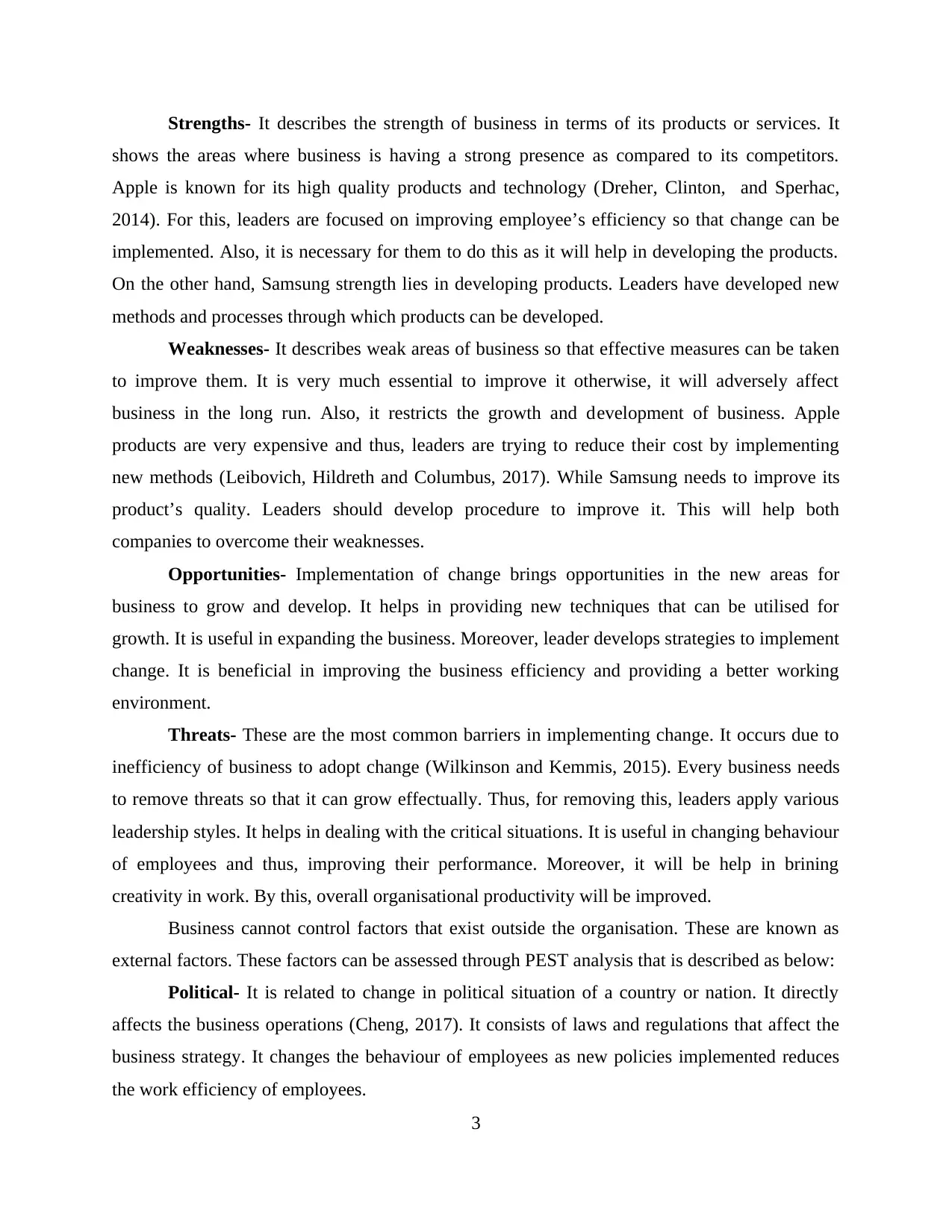
Strengths- It describes the strength of business in terms of its products or services. It
shows the areas where business is having a strong presence as compared to its competitors.
Apple is known for its high quality products and technology (Dreher, Clinton, and Sperhac,
2014). For this, leaders are focused on improving employee’s efficiency so that change can be
implemented. Also, it is necessary for them to do this as it will help in developing the products.
On the other hand, Samsung strength lies in developing products. Leaders have developed new
methods and processes through which products can be developed.
Weaknesses- It describes weak areas of business so that effective measures can be taken
to improve them. It is very much essential to improve it otherwise, it will adversely affect
business in the long run. Also, it restricts the growth and development of business. Apple
products are very expensive and thus, leaders are trying to reduce their cost by implementing
new methods (Leibovich, Hildreth and Columbus, 2017). While Samsung needs to improve its
product’s quality. Leaders should develop procedure to improve it. This will help both
companies to overcome their weaknesses.
Opportunities- Implementation of change brings opportunities in the new areas for
business to grow and develop. It helps in providing new techniques that can be utilised for
growth. It is useful in expanding the business. Moreover, leader develops strategies to implement
change. It is beneficial in improving the business efficiency and providing a better working
environment.
Threats- These are the most common barriers in implementing change. It occurs due to
inefficiency of business to adopt change (Wilkinson and Kemmis, 2015). Every business needs
to remove threats so that it can grow effectually. Thus, for removing this, leaders apply various
leadership styles. It helps in dealing with the critical situations. It is useful in changing behaviour
of employees and thus, improving their performance. Moreover, it will be help in brining
creativity in work. By this, overall organisational productivity will be improved.
Business cannot control factors that exist outside the organisation. These are known as
external factors. These factors can be assessed through PEST analysis that is described as below:
Political- It is related to change in political situation of a country or nation. It directly
affects the business operations (Cheng, 2017). It consists of laws and regulations that affect the
business strategy. It changes the behaviour of employees as new policies implemented reduces
the work efficiency of employees.
3
shows the areas where business is having a strong presence as compared to its competitors.
Apple is known for its high quality products and technology (Dreher, Clinton, and Sperhac,
2014). For this, leaders are focused on improving employee’s efficiency so that change can be
implemented. Also, it is necessary for them to do this as it will help in developing the products.
On the other hand, Samsung strength lies in developing products. Leaders have developed new
methods and processes through which products can be developed.
Weaknesses- It describes weak areas of business so that effective measures can be taken
to improve them. It is very much essential to improve it otherwise, it will adversely affect
business in the long run. Also, it restricts the growth and development of business. Apple
products are very expensive and thus, leaders are trying to reduce their cost by implementing
new methods (Leibovich, Hildreth and Columbus, 2017). While Samsung needs to improve its
product’s quality. Leaders should develop procedure to improve it. This will help both
companies to overcome their weaknesses.
Opportunities- Implementation of change brings opportunities in the new areas for
business to grow and develop. It helps in providing new techniques that can be utilised for
growth. It is useful in expanding the business. Moreover, leader develops strategies to implement
change. It is beneficial in improving the business efficiency and providing a better working
environment.
Threats- These are the most common barriers in implementing change. It occurs due to
inefficiency of business to adopt change (Wilkinson and Kemmis, 2015). Every business needs
to remove threats so that it can grow effectually. Thus, for removing this, leaders apply various
leadership styles. It helps in dealing with the critical situations. It is useful in changing behaviour
of employees and thus, improving their performance. Moreover, it will be help in brining
creativity in work. By this, overall organisational productivity will be improved.
Business cannot control factors that exist outside the organisation. These are known as
external factors. These factors can be assessed through PEST analysis that is described as below:
Political- It is related to change in political situation of a country or nation. It directly
affects the business operations (Cheng, 2017). It consists of laws and regulations that affect the
business strategy. It changes the behaviour of employees as new policies implemented reduces
the work efficiency of employees.
3
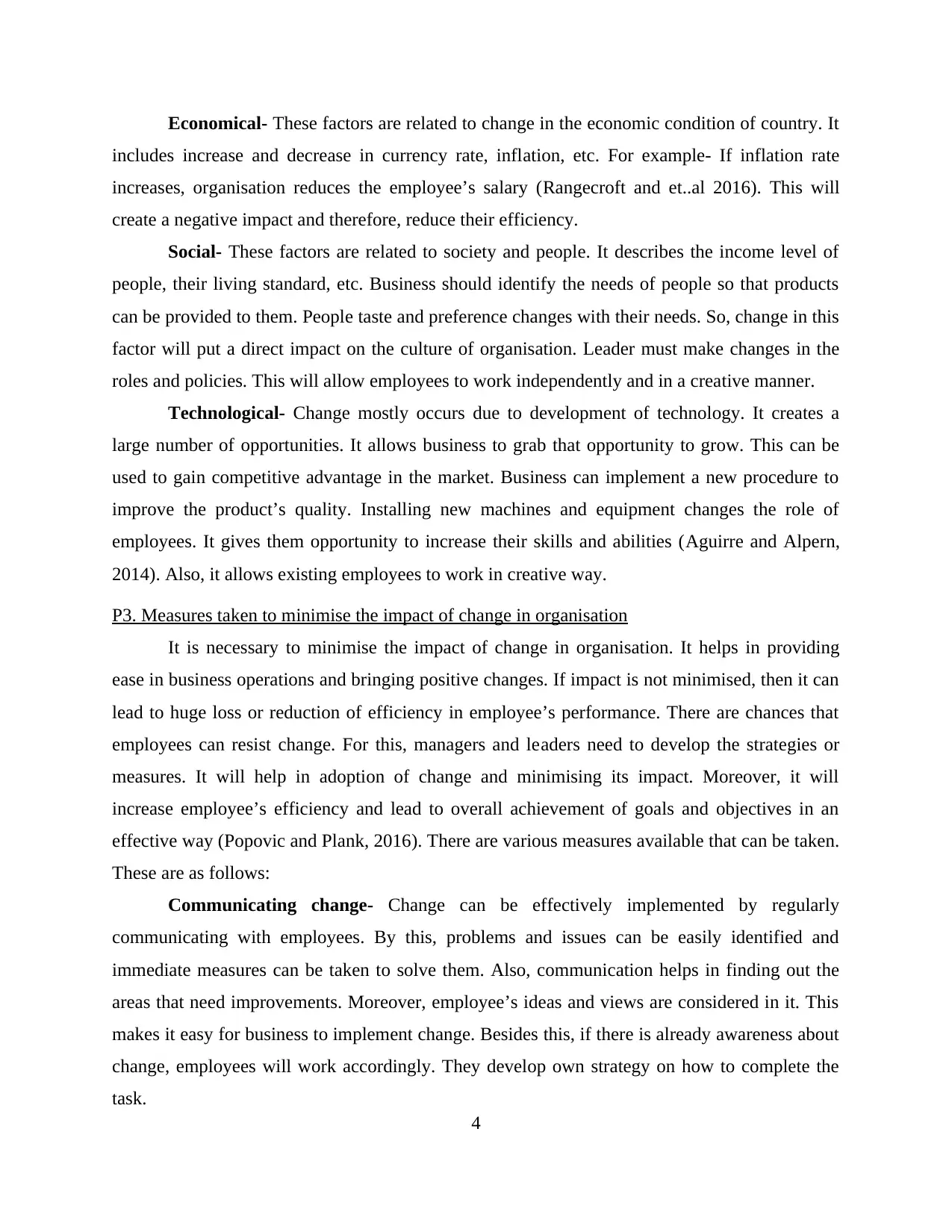
Economical- These factors are related to change in the economic condition of country. It
includes increase and decrease in currency rate, inflation, etc. For example- If inflation rate
increases, organisation reduces the employee’s salary (Rangecroft and et..al 2016). This will
create a negative impact and therefore, reduce their efficiency.
Social- These factors are related to society and people. It describes the income level of
people, their living standard, etc. Business should identify the needs of people so that products
can be provided to them. People taste and preference changes with their needs. So, change in this
factor will put a direct impact on the culture of organisation. Leader must make changes in the
roles and policies. This will allow employees to work independently and in a creative manner.
Technological- Change mostly occurs due to development of technology. It creates a
large number of opportunities. It allows business to grab that opportunity to grow. This can be
used to gain competitive advantage in the market. Business can implement a new procedure to
improve the product’s quality. Installing new machines and equipment changes the role of
employees. It gives them opportunity to increase their skills and abilities (Aguirre and Alpern,
2014). Also, it allows existing employees to work in creative way.
P3. Measures taken to minimise the impact of change in organisation
It is necessary to minimise the impact of change in organisation. It helps in providing
ease in business operations and bringing positive changes. If impact is not minimised, then it can
lead to huge loss or reduction of efficiency in employee’s performance. There are chances that
employees can resist change. For this, managers and leaders need to develop the strategies or
measures. It will help in adoption of change and minimising its impact. Moreover, it will
increase employee’s efficiency and lead to overall achievement of goals and objectives in an
effective way (Popovic and Plank, 2016). There are various measures available that can be taken.
These are as follows:
Communicating change- Change can be effectively implemented by regularly
communicating with employees. By this, problems and issues can be easily identified and
immediate measures can be taken to solve them. Also, communication helps in finding out the
areas that need improvements. Moreover, employee’s ideas and views are considered in it. This
makes it easy for business to implement change. Besides this, if there is already awareness about
change, employees will work accordingly. They develop own strategy on how to complete the
task.
4
includes increase and decrease in currency rate, inflation, etc. For example- If inflation rate
increases, organisation reduces the employee’s salary (Rangecroft and et..al 2016). This will
create a negative impact and therefore, reduce their efficiency.
Social- These factors are related to society and people. It describes the income level of
people, their living standard, etc. Business should identify the needs of people so that products
can be provided to them. People taste and preference changes with their needs. So, change in this
factor will put a direct impact on the culture of organisation. Leader must make changes in the
roles and policies. This will allow employees to work independently and in a creative manner.
Technological- Change mostly occurs due to development of technology. It creates a
large number of opportunities. It allows business to grab that opportunity to grow. This can be
used to gain competitive advantage in the market. Business can implement a new procedure to
improve the product’s quality. Installing new machines and equipment changes the role of
employees. It gives them opportunity to increase their skills and abilities (Aguirre and Alpern,
2014). Also, it allows existing employees to work in creative way.
P3. Measures taken to minimise the impact of change in organisation
It is necessary to minimise the impact of change in organisation. It helps in providing
ease in business operations and bringing positive changes. If impact is not minimised, then it can
lead to huge loss or reduction of efficiency in employee’s performance. There are chances that
employees can resist change. For this, managers and leaders need to develop the strategies or
measures. It will help in adoption of change and minimising its impact. Moreover, it will
increase employee’s efficiency and lead to overall achievement of goals and objectives in an
effective way (Popovic and Plank, 2016). There are various measures available that can be taken.
These are as follows:
Communicating change- Change can be effectively implemented by regularly
communicating with employees. By this, problems and issues can be easily identified and
immediate measures can be taken to solve them. Also, communication helps in finding out the
areas that need improvements. Moreover, employee’s ideas and views are considered in it. This
makes it easy for business to implement change. Besides this, if there is already awareness about
change, employees will work accordingly. They develop own strategy on how to complete the
task.
4
⊘ This is a preview!⊘
Do you want full access?
Subscribe today to unlock all pages.

Trusted by 1+ million students worldwide
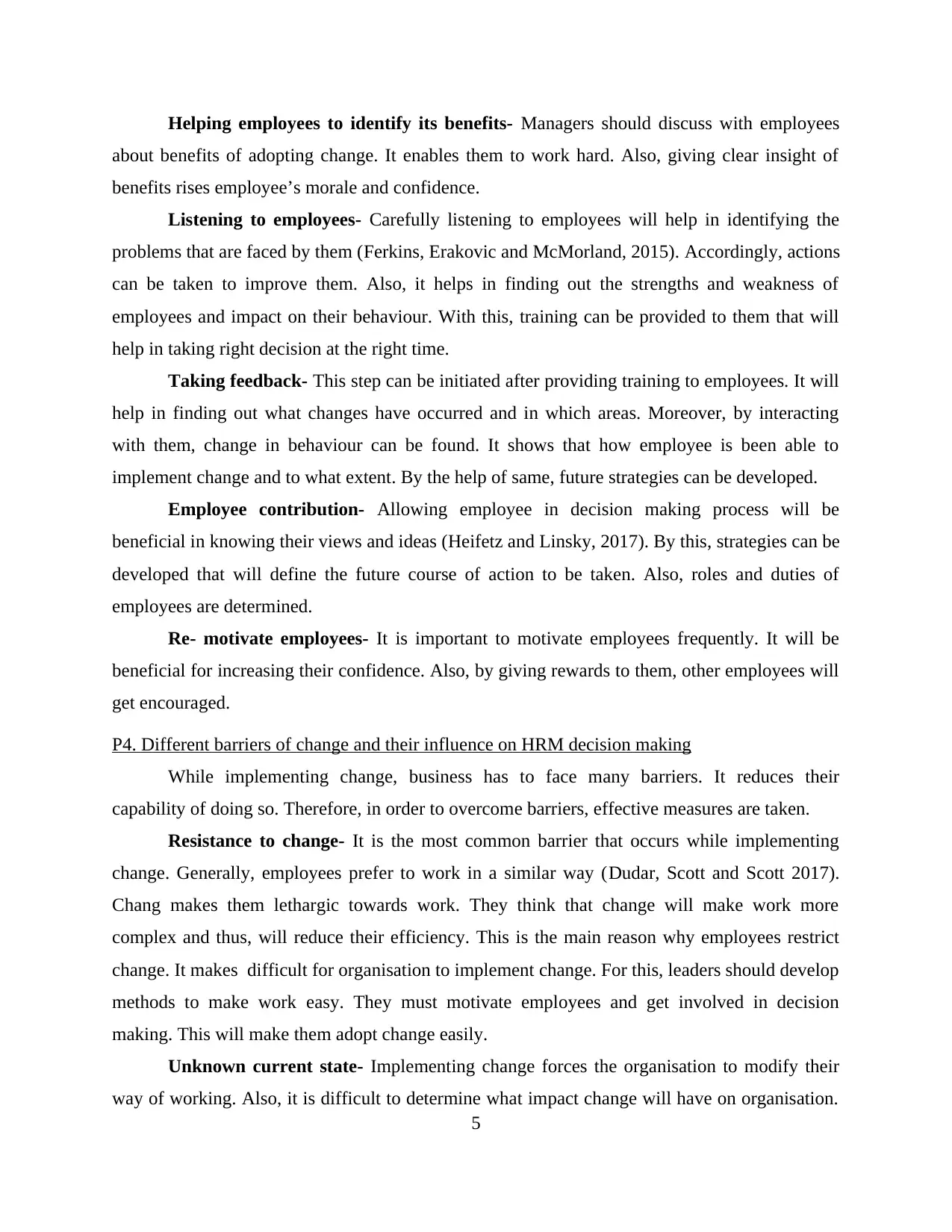
Helping employees to identify its benefits- Managers should discuss with employees
about benefits of adopting change. It enables them to work hard. Also, giving clear insight of
benefits rises employee’s morale and confidence.
Listening to employees- Carefully listening to employees will help in identifying the
problems that are faced by them (Ferkins, Erakovic and McMorland, 2015). Accordingly, actions
can be taken to improve them. Also, it helps in finding out the strengths and weakness of
employees and impact on their behaviour. With this, training can be provided to them that will
help in taking right decision at the right time.
Taking feedback- This step can be initiated after providing training to employees. It will
help in finding out what changes have occurred and in which areas. Moreover, by interacting
with them, change in behaviour can be found. It shows that how employee is been able to
implement change and to what extent. By the help of same, future strategies can be developed.
Employee contribution- Allowing employee in decision making process will be
beneficial in knowing their views and ideas (Heifetz and Linsky, 2017). By this, strategies can be
developed that will define the future course of action to be taken. Also, roles and duties of
employees are determined.
Re- motivate employees- It is important to motivate employees frequently. It will be
beneficial for increasing their confidence. Also, by giving rewards to them, other employees will
get encouraged.
P4. Different barriers of change and their influence on HRM decision making
While implementing change, business has to face many barriers. It reduces their
capability of doing so. Therefore, in order to overcome barriers, effective measures are taken.
Resistance to change- It is the most common barrier that occurs while implementing
change. Generally, employees prefer to work in a similar way (Dudar, Scott and Scott 2017).
Chang makes them lethargic towards work. They think that change will make work more
complex and thus, will reduce their efficiency. This is the main reason why employees restrict
change. It makes difficult for organisation to implement change. For this, leaders should develop
methods to make work easy. They must motivate employees and get involved in decision
making. This will make them adopt change easily.
Unknown current state- Implementing change forces the organisation to modify their
way of working. Also, it is difficult to determine what impact change will have on organisation.
5
about benefits of adopting change. It enables them to work hard. Also, giving clear insight of
benefits rises employee’s morale and confidence.
Listening to employees- Carefully listening to employees will help in identifying the
problems that are faced by them (Ferkins, Erakovic and McMorland, 2015). Accordingly, actions
can be taken to improve them. Also, it helps in finding out the strengths and weakness of
employees and impact on their behaviour. With this, training can be provided to them that will
help in taking right decision at the right time.
Taking feedback- This step can be initiated after providing training to employees. It will
help in finding out what changes have occurred and in which areas. Moreover, by interacting
with them, change in behaviour can be found. It shows that how employee is been able to
implement change and to what extent. By the help of same, future strategies can be developed.
Employee contribution- Allowing employee in decision making process will be
beneficial in knowing their views and ideas (Heifetz and Linsky, 2017). By this, strategies can be
developed that will define the future course of action to be taken. Also, roles and duties of
employees are determined.
Re- motivate employees- It is important to motivate employees frequently. It will be
beneficial for increasing their confidence. Also, by giving rewards to them, other employees will
get encouraged.
P4. Different barriers of change and their influence on HRM decision making
While implementing change, business has to face many barriers. It reduces their
capability of doing so. Therefore, in order to overcome barriers, effective measures are taken.
Resistance to change- It is the most common barrier that occurs while implementing
change. Generally, employees prefer to work in a similar way (Dudar, Scott and Scott 2017).
Chang makes them lethargic towards work. They think that change will make work more
complex and thus, will reduce their efficiency. This is the main reason why employees restrict
change. It makes difficult for organisation to implement change. For this, leaders should develop
methods to make work easy. They must motivate employees and get involved in decision
making. This will make them adopt change easily.
Unknown current state- Implementing change forces the organisation to modify their
way of working. Also, it is difficult to determine what impact change will have on organisation.
5
Paraphrase This Document
Need a fresh take? Get an instant paraphrase of this document with our AI Paraphraser
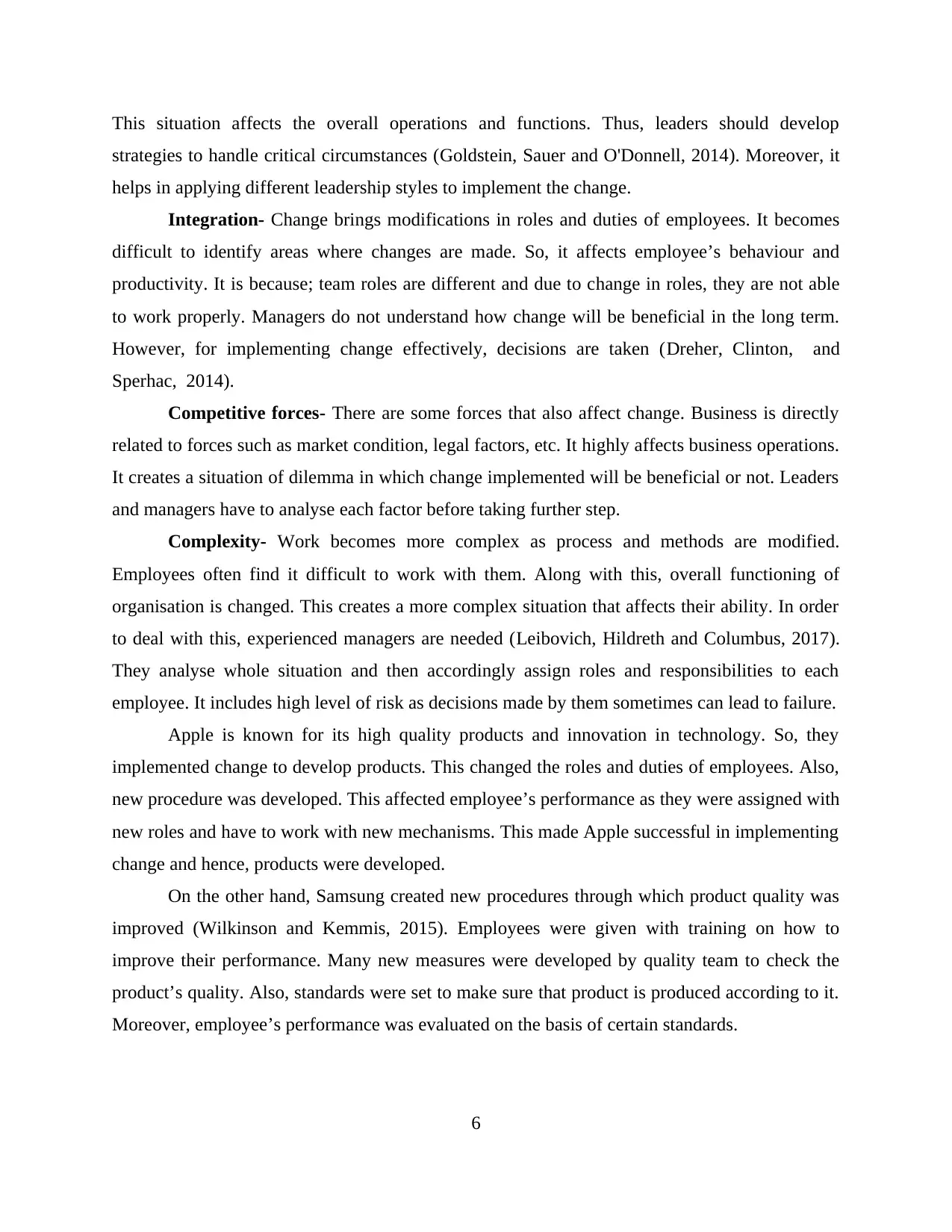
This situation affects the overall operations and functions. Thus, leaders should develop
strategies to handle critical circumstances (Goldstein, Sauer and O'Donnell, 2014). Moreover, it
helps in applying different leadership styles to implement the change.
Integration- Change brings modifications in roles and duties of employees. It becomes
difficult to identify areas where changes are made. So, it affects employee’s behaviour and
productivity. It is because; team roles are different and due to change in roles, they are not able
to work properly. Managers do not understand how change will be beneficial in the long term.
However, for implementing change effectively, decisions are taken (Dreher, Clinton, and
Sperhac, 2014).
Competitive forces- There are some forces that also affect change. Business is directly
related to forces such as market condition, legal factors, etc. It highly affects business operations.
It creates a situation of dilemma in which change implemented will be beneficial or not. Leaders
and managers have to analyse each factor before taking further step.
Complexity- Work becomes more complex as process and methods are modified.
Employees often find it difficult to work with them. Along with this, overall functioning of
organisation is changed. This creates a more complex situation that affects their ability. In order
to deal with this, experienced managers are needed (Leibovich, Hildreth and Columbus, 2017).
They analyse whole situation and then accordingly assign roles and responsibilities to each
employee. It includes high level of risk as decisions made by them sometimes can lead to failure.
Apple is known for its high quality products and innovation in technology. So, they
implemented change to develop products. This changed the roles and duties of employees. Also,
new procedure was developed. This affected employee’s performance as they were assigned with
new roles and have to work with new mechanisms. This made Apple successful in implementing
change and hence, products were developed.
On the other hand, Samsung created new procedures through which product quality was
improved (Wilkinson and Kemmis, 2015). Employees were given with training on how to
improve their performance. Many new measures were developed by quality team to check the
product’s quality. Also, standards were set to make sure that product is produced according to it.
Moreover, employee’s performance was evaluated on the basis of certain standards.
6
strategies to handle critical circumstances (Goldstein, Sauer and O'Donnell, 2014). Moreover, it
helps in applying different leadership styles to implement the change.
Integration- Change brings modifications in roles and duties of employees. It becomes
difficult to identify areas where changes are made. So, it affects employee’s behaviour and
productivity. It is because; team roles are different and due to change in roles, they are not able
to work properly. Managers do not understand how change will be beneficial in the long term.
However, for implementing change effectively, decisions are taken (Dreher, Clinton, and
Sperhac, 2014).
Competitive forces- There are some forces that also affect change. Business is directly
related to forces such as market condition, legal factors, etc. It highly affects business operations.
It creates a situation of dilemma in which change implemented will be beneficial or not. Leaders
and managers have to analyse each factor before taking further step.
Complexity- Work becomes more complex as process and methods are modified.
Employees often find it difficult to work with them. Along with this, overall functioning of
organisation is changed. This creates a more complex situation that affects their ability. In order
to deal with this, experienced managers are needed (Leibovich, Hildreth and Columbus, 2017).
They analyse whole situation and then accordingly assign roles and responsibilities to each
employee. It includes high level of risk as decisions made by them sometimes can lead to failure.
Apple is known for its high quality products and innovation in technology. So, they
implemented change to develop products. This changed the roles and duties of employees. Also,
new procedure was developed. This affected employee’s performance as they were assigned with
new roles and have to work with new mechanisms. This made Apple successful in implementing
change and hence, products were developed.
On the other hand, Samsung created new procedures through which product quality was
improved (Wilkinson and Kemmis, 2015). Employees were given with training on how to
improve their performance. Many new measures were developed by quality team to check the
product’s quality. Also, standards were set to make sure that product is produced according to it.
Moreover, employee’s performance was evaluated on the basis of certain standards.
6

P5. Different leadership approaches to deal with change
Leaders play a crucial role in implementing change within organisation. They motivate
and guide employees to work according to change. Also, leader helps employees to adopt
change. They take effective decision by applying various leadership styles and using experience.
It helps in bringing creativity in work and improving employee’s efficiency. There are some
leadership approaches followed by the leader. These are described as below:
Creative- This approach is followed by the leader to find out new methods or ways to
accomplish goals (Cheng, 2017). Leader communicates with employees and guides them to work
in different ways. By this, work becomes easy to complete.
Open communication- In this, leader openly communicates with employees. He takes
his views and ideas on how change can be implemented. The roles and duties are assigned to
them according to their skills and abilities. It helps the leader to freely work with them and
developing a strong bond. Employees also help and support each other in adopting change.
Leader gives suggestions to them to work in a creative way.
Situational leadership- This approach is entirely based on the situation. In this, leader
analyses current situation and then takes the decision (Goldstein, Sauer and O'Donnell, 2014).
Besides this, leader changes his style in particular time to deal with the situation. It also helps in
controlling the impact of change.
Transformational- In this, goals are set by identifying strengths and weaknesses of
employees so that it will be easy to achieve those goals and objectives.
Cross cultural- In this, leader allows employees to participate in decision making
process. By this, it is easy to effectively work with them. Also, employees express their ideas and
views. This helps in developing the strategies and plans. A strong relationship is built by the
leader with employees. It helps in completing tasks in less time with their own strategy and
decisions. Moreover, getting employee’s reviews is beneficial in implementing the change.
Servant- In this, long term goals are set by leaders. It is achieved by setting short term
goals. These goals are achieved by creating teams and assigning tasks to them. In this, leader
focuses on ethics rather than culture (Dreher, Clinton, and Sperhac, 2014). It helps in the growth
and development of employees.
7
Leaders play a crucial role in implementing change within organisation. They motivate
and guide employees to work according to change. Also, leader helps employees to adopt
change. They take effective decision by applying various leadership styles and using experience.
It helps in bringing creativity in work and improving employee’s efficiency. There are some
leadership approaches followed by the leader. These are described as below:
Creative- This approach is followed by the leader to find out new methods or ways to
accomplish goals (Cheng, 2017). Leader communicates with employees and guides them to work
in different ways. By this, work becomes easy to complete.
Open communication- In this, leader openly communicates with employees. He takes
his views and ideas on how change can be implemented. The roles and duties are assigned to
them according to their skills and abilities. It helps the leader to freely work with them and
developing a strong bond. Employees also help and support each other in adopting change.
Leader gives suggestions to them to work in a creative way.
Situational leadership- This approach is entirely based on the situation. In this, leader
analyses current situation and then takes the decision (Goldstein, Sauer and O'Donnell, 2014).
Besides this, leader changes his style in particular time to deal with the situation. It also helps in
controlling the impact of change.
Transformational- In this, goals are set by identifying strengths and weaknesses of
employees so that it will be easy to achieve those goals and objectives.
Cross cultural- In this, leader allows employees to participate in decision making
process. By this, it is easy to effectively work with them. Also, employees express their ideas and
views. This helps in developing the strategies and plans. A strong relationship is built by the
leader with employees. It helps in completing tasks in less time with their own strategy and
decisions. Moreover, getting employee’s reviews is beneficial in implementing the change.
Servant- In this, long term goals are set by leaders. It is achieved by setting short term
goals. These goals are achieved by creating teams and assigning tasks to them. In this, leader
focuses on ethics rather than culture (Dreher, Clinton, and Sperhac, 2014). It helps in the growth
and development of employees.
7
⊘ This is a preview!⊘
Do you want full access?
Subscribe today to unlock all pages.

Trusted by 1+ million students worldwide

Comfortable with ambiguity- In this, leader is already having knowledge of how to deal
with change. Therefore, he develops the strategy accordingly. In this way, impact of change is
minimised. This helps in dealing with the critical and harsh situation.
CONCLUSION
From this report, it can be concluded that every business requires change at a particular
stage and time. Change is an integral part of business. Without this, business cannot grow and
develop. It helps business to develop strategies and methods to enhance its efficiency. The
implementation of change in business is known as change management. There are certain drivers
that can affect implementation of change in business. These drivers can be internally or
externally related to business. It is necessary to minimise its impact in organisation. It helps in
providing ease in business operations and bringing positive changes. While implementing it,
business has to face many barriers. It reduces their capability of doing so. Leaders play a crucial
role in implementing the change within organisation. They motivate and guide employees to
work according to change.
8
with change. Therefore, he develops the strategy accordingly. In this way, impact of change is
minimised. This helps in dealing with the critical and harsh situation.
CONCLUSION
From this report, it can be concluded that every business requires change at a particular
stage and time. Change is an integral part of business. Without this, business cannot grow and
develop. It helps business to develop strategies and methods to enhance its efficiency. The
implementation of change in business is known as change management. There are certain drivers
that can affect implementation of change in business. These drivers can be internally or
externally related to business. It is necessary to minimise its impact in organisation. It helps in
providing ease in business operations and bringing positive changes. While implementing it,
business has to face many barriers. It reduces their capability of doing so. Leaders play a crucial
role in implementing the change within organisation. They motivate and guide employees to
work according to change.
8
Paraphrase This Document
Need a fresh take? Get an instant paraphrase of this document with our AI Paraphraser
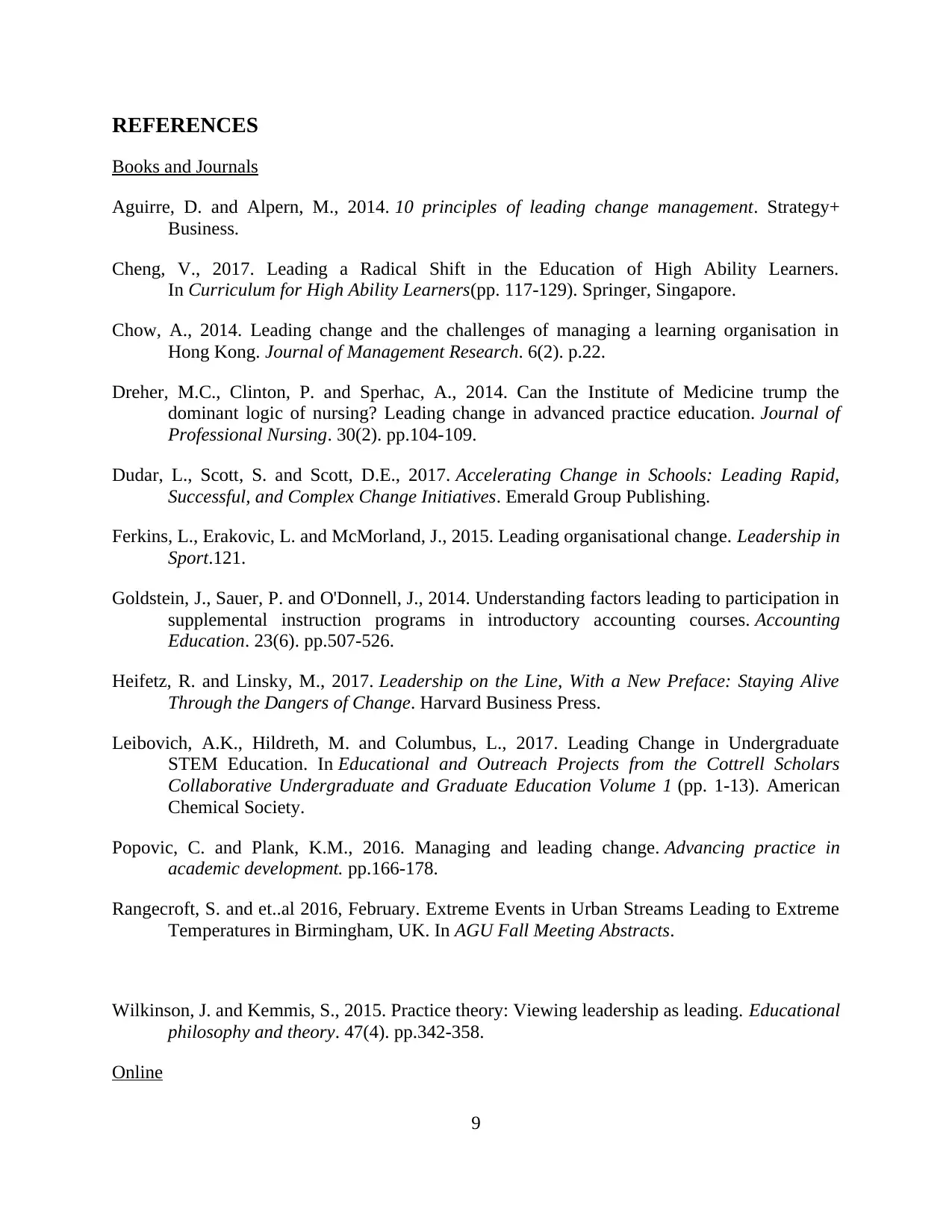
REFERENCES
Books and Journals
Aguirre, D. and Alpern, M., 2014. 10 principles of leading change management. Strategy+
Business.
Cheng, V., 2017. Leading a Radical Shift in the Education of High Ability Learners.
In Curriculum for High Ability Learners(pp. 117-129). Springer, Singapore.
Chow, A., 2014. Leading change and the challenges of managing a learning organisation in
Hong Kong. Journal of Management Research. 6(2). p.22.
Dreher, M.C., Clinton, P. and Sperhac, A., 2014. Can the Institute of Medicine trump the
dominant logic of nursing? Leading change in advanced practice education. Journal of
Professional Nursing. 30(2). pp.104-109.
Dudar, L., Scott, S. and Scott, D.E., 2017. Accelerating Change in Schools: Leading Rapid,
Successful, and Complex Change Initiatives. Emerald Group Publishing.
Ferkins, L., Erakovic, L. and McMorland, J., 2015. Leading organisational change. Leadership in
Sport.121.
Goldstein, J., Sauer, P. and O'Donnell, J., 2014. Understanding factors leading to participation in
supplemental instruction programs in introductory accounting courses. Accounting
Education. 23(6). pp.507-526.
Heifetz, R. and Linsky, M., 2017. Leadership on the Line, With a New Preface: Staying Alive
Through the Dangers of Change. Harvard Business Press.
Leibovich, A.K., Hildreth, M. and Columbus, L., 2017. Leading Change in Undergraduate
STEM Education. In Educational and Outreach Projects from the Cottrell Scholars
Collaborative Undergraduate and Graduate Education Volume 1 (pp. 1-13). American
Chemical Society.
Popovic, C. and Plank, K.M., 2016. Managing and leading change. Advancing practice in
academic development. pp.166-178.
Rangecroft, S. and et..al 2016, February. Extreme Events in Urban Streams Leading to Extreme
Temperatures in Birmingham, UK. In AGU Fall Meeting Abstracts.
Wilkinson, J. and Kemmis, S., 2015. Practice theory: Viewing leadership as leading. Educational
philosophy and theory. 47(4). pp.342-358.
Online
9
Books and Journals
Aguirre, D. and Alpern, M., 2014. 10 principles of leading change management. Strategy+
Business.
Cheng, V., 2017. Leading a Radical Shift in the Education of High Ability Learners.
In Curriculum for High Ability Learners(pp. 117-129). Springer, Singapore.
Chow, A., 2014. Leading change and the challenges of managing a learning organisation in
Hong Kong. Journal of Management Research. 6(2). p.22.
Dreher, M.C., Clinton, P. and Sperhac, A., 2014. Can the Institute of Medicine trump the
dominant logic of nursing? Leading change in advanced practice education. Journal of
Professional Nursing. 30(2). pp.104-109.
Dudar, L., Scott, S. and Scott, D.E., 2017. Accelerating Change in Schools: Leading Rapid,
Successful, and Complex Change Initiatives. Emerald Group Publishing.
Ferkins, L., Erakovic, L. and McMorland, J., 2015. Leading organisational change. Leadership in
Sport.121.
Goldstein, J., Sauer, P. and O'Donnell, J., 2014. Understanding factors leading to participation in
supplemental instruction programs in introductory accounting courses. Accounting
Education. 23(6). pp.507-526.
Heifetz, R. and Linsky, M., 2017. Leadership on the Line, With a New Preface: Staying Alive
Through the Dangers of Change. Harvard Business Press.
Leibovich, A.K., Hildreth, M. and Columbus, L., 2017. Leading Change in Undergraduate
STEM Education. In Educational and Outreach Projects from the Cottrell Scholars
Collaborative Undergraduate and Graduate Education Volume 1 (pp. 1-13). American
Chemical Society.
Popovic, C. and Plank, K.M., 2016. Managing and leading change. Advancing practice in
academic development. pp.166-178.
Rangecroft, S. and et..al 2016, February. Extreme Events in Urban Streams Leading to Extreme
Temperatures in Birmingham, UK. In AGU Fall Meeting Abstracts.
Wilkinson, J. and Kemmis, S., 2015. Practice theory: Viewing leadership as leading. Educational
philosophy and theory. 47(4). pp.342-358.
Online
9

Organisational change and leadership styles. 2012. [Online]. Available through:
<http://smallbusiness.chron.com/organizational-change-leadership-styles-3048.html>.
10
<http://smallbusiness.chron.com/organizational-change-leadership-styles-3048.html>.
10
⊘ This is a preview!⊘
Do you want full access?
Subscribe today to unlock all pages.

Trusted by 1+ million students worldwide
1 out of 12
Related Documents
Your All-in-One AI-Powered Toolkit for Academic Success.
+13062052269
info@desklib.com
Available 24*7 on WhatsApp / Email
![[object Object]](/_next/static/media/star-bottom.7253800d.svg)
Unlock your academic potential
Copyright © 2020–2025 A2Z Services. All Rights Reserved. Developed and managed by ZUCOL.





